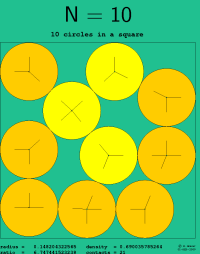Since this does seem to be a kind of packing problem I searched for prior explorations, and found a list of packings for equal-circles within a square at:
The best known packing for N = 10 is shown as:

The coordinates for the points are:
1 -0.055497063038156969690135505676 -0.351795677434771201331992637257
2 0.240911582092300627645879219810 -0.351795677434771201331992637257
3 -0.351795677434771201331992637257 -0.343720034134076580133895794673
4 0.055387032304313603995977911771 -0.076908787408790806346486820340
5 0.351795677434771201331992637257 -0.076908787408790806346486820339
6 -0.351795677434771201331992637257 -0.047311389003618982797881069187
7 -0.132623434010086730621834242216 0.152242144215576109267055784036
8 0.351795677434771201331992637257 0.219499857721666790989527905147
9 -0.351795677434771201331992637257 0.351795677434771201331992637257
10 0.086548809414597740088324152827 0.351795677434771201331992637257
Plotted:
pts = {{-0.0554971`, -0.351796`}, {0.240912`, -0.351796`}, {-0.351796`, -0.34372`},
{0.055387`, -0.0769088`}, {0.351796`, -0.0769088`}, {-0.351796`, -0.0473114`},
{-0.132623`, 0.152242`}, {0.351796`, 0.2195`}, {-0.351796`, 0.351796`},
{0.0865488`, 0.351796`}};
m = Min @ pts;
Graphics[{
{LightBlue, Rectangle[{m, m}, -{m, m}]},
{Red, AbsolutePointSize[15], Point @ pts}
}]

The minimal distance between points (full precision, and scaled to a unit square) is: 0.42127954398...
I suspect a better solution will not be forthcoming.
Old comments
Blatantly copying Simon's code, but messing with optimization parameters I get this:
pts = Array[{x[#], y[#]} &, 10];
mindist2 = Min[#.# & /@ Subtract @@@ Subsets[pts, {2}]];
vars = Flatten[pts];
constraints = Thread[0 <= vars <= 1];
{md2, rules} =
NMaximize[{mindist2, constraints}, vars,
Method -> {"DifferentialEvolution",
"CrossProbability" -> 0.6,
"ScalingFactor" -> 0.68,
"RandomSeed" -> 42}];
minimaldistance = Sqrt[md2]
Graphics[{Yellow, Rectangle[], Red, PointSize[Large], Point[pts /. rules]}]
0.417788

This is a better result, but I have zero confidence that it is optimal. I wonder how else one might approach this.






NMaximize. $\endgroup$